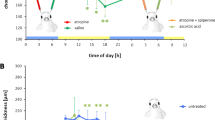Abstract
The involvement of catecholaminergic and indoleaminergic systems in the modulation of the standing potential of the eye was tested in chickens by means of an indirect electrooculography method and direct current electroretinogram recordings. D,L α- monofluoromethyl dopa (MFMD), 50 and 100 nmol), a highly specific inactivator of aromatic L-amino acid decarboxylase, was injected intravitreally. This treatment is known to induce a selective and irreversible blockade of dopamine and 5-hydroxytryptamine biosynthesis. Five hours after drug injection an important increase in the standing potential appeared. The light peak was delayed by about 5 min but its amplitude was unchanged. The return of the standing potential to basal value during maintained illumination was delayed by 5–10 min. The time course of the dark trough was not modified. The intensity-voltage functions were also studied for the various electroretinogram components, 5 hr after MFMD. The voltage of the b-wave was reduced (by 65% with the highest intensity), while the other components were little affected. Substantial reduction in dopamine and 5-hydroxytryptamine concentrations were found in treated retinas. These data, together with previous results, suggest that the standing potential of the chicken eye may be modulated by a balance between catecholamine and indoleamine systems.
Similar content being viewed by others
References
Ehinger B. Functional role for dopamine in the retina. In Osborne NN, Chader G, eds. Progress in Retinal Research, Vol 2. Oxford: Pergamon Press, 1983; 213–32.
Osborne NN. Indoleamines in the eye with special reference to the serotonergic neurones of the retina. In Osborne NN, Chader G, eds. Progress in Retinal Research, Vol 3. Oxford: Pergamon Press, 1984; 61–104.
Qu ZX, Fertel R, Neff NH, Hadjiconstantinou M. Pharmacological characterization of rat retinal dopamine receptors. J Pharm Exp Ther 1989; 248: 621–25.
Dawis N, Niemeyer G. Dopamine influences the light peak in the perfused mammalian eye. Invest Ophthalmol Vis Sci 1986; 27: 330–35.
Dawis N, Niemeyer G. Similarity and diversity of monoamines in their effects on the standing potential, light peak and electroretinogram of the perfused cat eye. Clin Vis Sci 1988; 3: 109–18.
Griff ER, Steinberg RH. Origin of the light peak: in vitro study on Gekko gekko. J Physiol (Lond) 1982; 331: 637–52.
Rudolf G, Wioland N, Kempf E, Bonaventure N. Electrooculographic study in the chicken after treatment with the neurotoxin 6-hydroxydopamine. Doc Ophthalmol, 1989, 72: 83–91.
Parkinson D, Rando RR. Effects of light on dopamine metabolism in the chick retina. J Neurochem 1983; 40: 39–46.
Kollonitsch J, Perkins LM, Patchett AA, Doldouras GA, Marburg S, Duggan DE, Maycock AL, Aster SD. Selective inhibitors of biosynthesis of aminergic neurotransmitters. Nature 1978; 274: 906–8.
Jung MJ, Palfreyman MG, Wagner J, Bey P, Ribereau-Gayon G, Zraika M, Koch-Weser J. Inhibition of monoamine synthesis by irreversible blockade of aromatic amino acid decarboxylase with alpha-monofluoromethyldopa. Life Sci 1979; 24: 1037–42.
Wioland N, Bonaventure N. Phototopic c-wave in the chicken ERG: sensitivity to sodium azide, epinephrine, sodium iodate, barbiturates and other general anesthetics. Doc Ophthalmol 1985; 60: 407–12.
Rudolf G, Wioland N, Bonaventure N. Participation des couches internes de la rétine à la genèse du ‘light peak’ de l'électrooculogramme chez le poulet. C R Acad Sci 1987; 305: 427–32.
Zarbin MA, Wawsley JK, Palacios JM, Kuhar MJ. Autoradiographic localization of high affinity GABA, benzodiazepine, dopaminergic, adrenergic and muscarinic cholinergic receptors in the rat, monkey and human retina. Brain Res 1986; 374: 75–92.
Dubocovich ML. Melatonin is a potent modulator of dopamine release in the retina. Nature 1983; 306: 782–784.
Texturius O, Nilsson SEG. Effects of intraocular irrigation with melatonin on the c-wave of the direct current electroretinogram and the standing potential of the eye in albino rabbits. Doc Ophthalmol 1987; 65: 97–111.
Wioland N, Rudolf G, Bonaventure N. Electrooculographic and electroretinographic study in the chicken after dopomine and haloperidol. Doc Ophtholmol 1990; 75: 175–180.
Author information
Authors and Affiliations
Rights and permissions
About this article
Cite this article
Rudolf, G., Wioland, N., Kempf, E. et al. EOG and ERG modifications induced in the chicken eye after blockade of catecholamine and 5-hydroxytryptamine biosynthesis. Doc Ophthalmol 76, 47–53 (1990). https://doi.org/10.1007/BF00140497
Issue Date:
DOI: https://doi.org/10.1007/BF00140497




